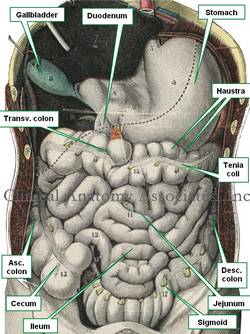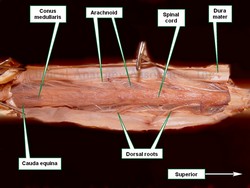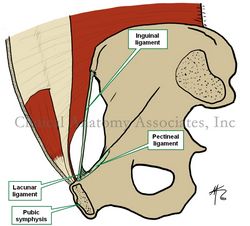
Medical Terminology Daily (MTD) is a blog sponsored by Clinical Anatomy Associates, Inc. as a service to the medical community. We post anatomical, medical or surgical terms, their meaning and usage, as well as biographical notes on anatomists, surgeons, and researchers through the ages. Be warned that some of the images used depict human anatomical specimens.
You are welcome to submit questions and suggestions using our "Contact Us" form. The information on this blog follows the terms on our "Privacy and Security Statement" and cannot be construed as medical guidance or instructions for treatment.
We have 582 guests online

Jean George Bachmann
(1877 – 1959)
French physician–physiologist whose experimental work in the early twentieth century provided the first clear functional description of a preferential interatrial conduction pathway. This structure, eponymically named “Bachmann’s bundle”, plays a central role in normal atrial activation and in the pathophysiology of interatrial block and atrial arrhythmias.
As a young man, Bachmann served as a merchant sailor, crossing the Atlantic multiple times. He emigrated to the United States in 1902 and earned his medical degree at the top of his class from Jefferson Medical College in Philadelphia in 1907. He stayed at this Medical College as a demonstrator and physiologist. In 1910, he joined Emory University in Atlanta. Between 1917 -1918 he served as a medical officer in the US Army. He retired from Emory in 1947 and continued his private medical practice until his death in 1959.
On the personal side, Bachmann was a man of many talents: a polyglot, he was fluent in German, French, Spanish and English. He was a chef in his own right and occasionally worked as a chef in international hotels. In fact, he paid his tuition at Jefferson Medical College, working both as a chef and as a language tutor.
The intrinsic cardiac conduction system was a major focus of cardiovascular research in the late nineteenth and early twentieth centuries. The atrioventricular (AV) node was discovered and described by Sunao Tawara and Karl Albert Aschoff in 1906, and the sinoatrial node by Arthur Keith and Martin Flack in 1907.
While the connections that distribute the electrical impulse from the AV node to the ventricles were known through the works of Wilhelm His Jr, in 1893 and Jan Evangelista Purkinje in 1839, the mechanism by which electrical impulses spread between the atria remained uncertain.
In 1916 Bachmann published a paper titled “The Inter-Auricular Time Interval” in the American Journal of Physiology. Bachmann measured activation times between the right and left atria and demonstrated that interruption of a distinct anterior interatrial muscular band resulted in delayed left atrial activation. He concluded that this band constituted the principal route for rapid interatrial conduction.
Subsequent anatomical and electrophysiological studies confirmed the importance of the structure described by Bachmann, which came to bear his name. Bachmann’s bundle is now recognized as a key determinant of atrial activation patterns, and its dysfunction is associated with interatrial block, atrial fibrillation, and abnormal P-wave morphology. His work remains foundational in both basic cardiac anatomy and clinical electrophysiology.
Sources and references
1. Bachmann G. “The inter-auricular time interval”. Am J Physiol. 1916;41:309–320.
2. Hurst JW. “Profiles in Cardiology: Jean George Bachmann (1877–1959)”. Clin Cardiol. 1987;10:185–187.
3. Lemery R, Guiraudon G, Veinot JP. “Anatomic description of Bachmann’s bundle and its relation to the atrial septum”. Am J Cardiol. 2003;91:148–152.
4. "Remembering the canonical discoverers of the core components of the mammalian cardiac conduction system: Keith and Flack, Aschoff and Tawara, His, and Purkinje" Icilio Cavero and Henry Holzgrefe Advances in Physiology Education 2022 46:4, 549-579.
5. Knol WG, de Vos CB, Crijns HJGM, et al. “The Bachmann bundle and interatrial conduction” Heart Rhythm. 2019;16:127–133.
6. “Iatrogenic biatrial flutter. The role of the Bachmann’s bundle” Constán E.; García F., Linde, A.. Complejo Hospitalario de Jaén, Jaén. Spain
7. Keith A, Flack M. The form and nature of the muscular connections between the primary divisions of the vertebrate heart. J Anat Physiol 41: 172–189, 1907.
"Clinical Anatomy Associates, Inc., and the contributors of "Medical Terminology Daily" wish to thank all individuals who donate their bodies and tissues for the advancement of education and research”.
Click here for more information
- Details
The word [haustrum] is Latin and refers to a sac or scoop-like leather bucket used by the Romans to draw water out of a well. The plural form is [haustra].
In anatomy, the word [haustrum] is used to refer to a sacculation or outpouching of the colon caused by the constant tonus contraction of the longitudinal muscle fibers found in the tenia coli, as well as the distribution of circular fibers. See accompanying image. Click the image for a larger depiction.
Since the small intestine is not necessarily always small in relation to the colon (because of food content, intestinal gases, or pathology), the location of the organ and the presence of haustra, as well as the presence of tenia coli and appendices epiploica, is used to recognize the organ as colon.
The term can also be used as an adjective and the colon can be said to be "haustrated".
The word seems to have been used for the first time by Albrecht Von Haller (1708 - 1777) a Swiss anatomist, botanist, and physiologist.
Sources:
1. "Dorlands's Illustrated Medical Dictionary" 26th Ed. W.B. Saunders 1994
2. "The origin of Medical Terms" Skinner, AH, 1970
3. "Tratado de Anatomia Humana" Testut et Latarjet 8 Ed. 1931 Salvat Editores, Spain
Image modified from the original from Testut and Latajet, 1931
- Details
|
The medical suffix [-algia] originates from the Greek [algos /algein] meaning "pain". The term is used in many medical words. Applications of this root term include:
|
|
| Back to MTD Main Page | Subscribe to MTD |
- Details
The ileum is an intraperitoneal organ, it is the third portion of the small intestine and part of the digestive tract, found distal to the duodenum and jejunum. The ileum is about 6-8 feet in length.
There is no clear anatomical boundary between the jejunum and ileum, as they blend smoothly one into the other. There are several gross changes from jejunum to ileum, one of them being that the complexity of the mesenteric arterial arches increases from proximal to distal.
The term [ileum] has a Greek origin from [ειλεός] meanings "twisted", referring to the "twisted" look of this third portion of the small intestine. When the term was first used Galen did not separate or differentiate jejunum from ileum. He called both the [intestinum tenuis] or "thin or delicate intestine". This term is still used for the smaller arterial and venous branches of the small intestine, the [vasa intestinii tenuis].
It seems that the term "ileum" or "ileus" was originally used to denote the distal portion of the intestine that got sick or "colicky", separating it from the jejunum which was usually found empty or devoid of food.
The terminal ileum ends at the ileocolic or ileocecal valve, where the small intestine empties its contents into the large intestine or colon.
Sources:
1. "Clinically Oriented Anatomy" Moore, KL. 3r Ed. Williams & Wilkins 1992
2. "The origin of Medical Terms" Skinner, AH, 1970
3. "Tratado de Anatomia Humana" Testut et Latarjet 8 Ed. 1931 Salvat Editores, Spain
Image modified from the original from Testut and Latarjet, 1931.
- Details
The conus medullaris is the lowest portion of the spinal cord, where it ends in a sharp cone at about the level of L1-L2. The conus medullaris continues inferiorly with a thin cord called the filum terminale (end thread) which attaches to the sacrum.
The fact that the spinal cord is shorter than the corresponding exit of the spinal nerves, causes the corresponding dorsal and ventral roots to create a structure that resembles a horse's tail inferior to the conus medullaris, called the cauda equina.
See the accompanying image. Click on the image for a larger version.
Image property of: Photographer: David M. Klein
- Details
This article is part of the series "A Moment in History" where we honor those who have contributed to the growth of medical knowledge in the areas of anatomy, medicine, surgery, and medical research.
Johannes Veslingius Mindanus (1598 – 1649). German surgeon, anatomist, botanist, and pharmacologist. Johann Vesling (mostly known by his Latinized name “Johannes Veslingius”) was born in a catholic family in Minden, Westphalia. He studied medicine in Leyden and Bologna. He later moved to the Venice medical college, where he became a professor of Anatomy in 1627. Veslingius had an interest in botany, which he pursued his whole life. Although German-born, Veslingius did most of his work and career in Italy.
In 1628 he traveled to Egypt and Jerusalem as a personal physician of Alvise Cornaro, the Venetian consul in Cairo. In 1632 he became a professor of anatomy and surgery at the University of Padua, in Italy, forcing his return from Jerusalem. At Padua, Veslingius became part of the long list of anatomists that followed Andreas Vesalius’ position.
Veslingius was the first to describe the arterial circle of the brain, eponymically tied today to Thomas Willis, and he was the first to name the soleus muscle, as it resembles the sole fish. In his words: “soleus, a figura piscis denominatus” translated “soleus, named for its fish shape”. Apparently, he was also the first to describe the pancreatic duct which lead to controversy with Wirsung. Veslingius was also the first to describe the four pulmonary veins, described as four of the great vessels.
Veslingius published his most important work, “Syntagma Anatomicum, publicis dissectionibus in auditorum usum diligenter aptatum”, in 1641. This work, which originally had no images, was republished in 1647 with full images in copper plates. This original work is important as it leaves the Vesalian tradition of posing the anatomical images with backgrounds and landscapes, dedicating the image solely to the anatomical information; in fact this is the first book to publish original images not copied or inspired from Vesalius’ Fabrica. This book was the first to influence Japanese anatomy.
Incredibly, Veslingius was accused of murdering Johan Georg Wirsung (1589 - 1643) with whom he had academic conflicts. Veslingius was acquitted of the accusation, and the name of Wirsung is today eponymously attached to the pancreatic duct.
The accompanying image is from the “Syntagma Anatomicum” and shows Veslingius with the following Latin words around him: “Ioannes Veslingius Mindanus Eques Hieros In Patauino Gymnasio Anatom. et Phar. Profess. Primarius” translated as: Johannes Veslingius Mindanus, Knight of Jerusalem, Primary Professor of Anatomy and Pharmacology of the School of Padua.
Below the image you can read: “Talis Apollinea floret Veslingius Arte. Purpureus nives pectore fulget Honor”, translated as: Veslingius flourishes by the art of Apollo who honors him by shining purple snow on his chest. Click on the image for a larger depiction and to see the Latin text.
Personal note: I am proud to have in my library catalog one of Veslingius’ original prints: “Tavole Anatomiche del Veslingio – Spiegate in Lingua Italiana” (Anatomical images from Veslingius, written in Italian), published in 1745 by Giovanni Battista Conzatti. Dr. Miranda
Original image courtesy of NLM. The title page of Syntagma Anatomicum courtesy of archive.org. Both images are in the public domain.
Sources:
1. “The Fabric of the Body. European Tradition of Anatomical Illustration” Roberts KB, Tomlinson JDW (1992) Oxford: Clarendon.
2. “The evolution of anatomical illustration and wax modelling in Italy from the 16th to early 19th centuries” Riva, A. et al. J. Anat. (2010) 216, 209–222
3. “The Anatomical School of Padua” Porzionato, A. et al. Anat Rec (Hoboken). 2012 Jun; 295(6):902-16
4. “The Origin of Medical Terms” Skinner, HA. 1970
5. "Johann Vesling (1598–1649):Seventeenth Century Anatomist of Padua and His Syntagma Anatomicum" SK Ghosh J Clin Anat 2014
Original image courtesy of the National Library of Medicine. The title page of Syntagma Anatomicum courtesy of archive.org. Both images are in the public domain.
- Details
The [lacunar ligament] is a half-moon shaped ligament that extends between the inguinal ligament (Poupart's ligament) superiorly and the pectineal ligament (Cooper's ligament) inferiorly. The lacunar ligament is at its narrowest at the point where the inguinal ligament and the pectineal ligament meet at the pubic tubercle where all three ligaments insert. The lacunar ligament is the medial boundary of the femoral ring.
The lacunar ligament was first described in 1765 by Don Antonio de Gimbernat y Arbós (1734 - 1816), who also described the importance of this ligament in the reduction of a strangulated femoral hernia.
In the anterior (open) approach to a strangulated femoral hernia, there is very little space at the femoral ring to enlarge it and allow reduction of the hernia contents. What Gimbernat did was to carefully cut the ligament from lateral to medial, enlarging the femoral ring and allowing reduction of the hernia. This was against the technique practiced at the time, which was to cut trough the inguinal ligament.
One of concerns when using this technique is the presence of the Corona Mortis, an anatomical variation in the area. Since the Corona Mortis is found posterior to the lacunar ligament, it can be unknowingly transected when repairing a femoral hernia from the anterior aspect.





